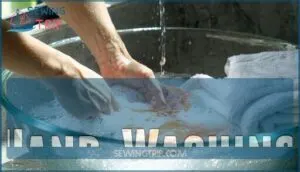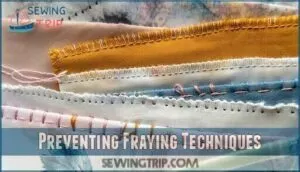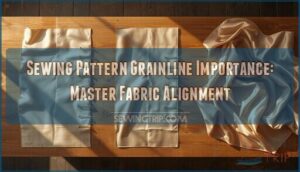This site is supported by our readers. We may earn a commission, at no cost to you, if you purchase through links.

For cotton and linen, toss it in the washing machine with warm water and detergent, just like you would for finished clothes. Delicate fabrics like silk or wool need a gentler touch—hand wash in cold water with mild soap.
Always trim loose threads to prevent fraying and consider serging or pinking the edges. Once washed, air drying is best to avoid shrinking.
A quick iron when it’s slightly damp smooths wrinkles and readies it for cutting. Different fabrics need different care, so knowing your material is half the battle.
Table Of Contents
Key Takeaways
- Wash fabric the same way you’ll wash the finished item to prevent shrinking, fading, and bleeding.
- Use mild detergent, skip fabric softeners, and air dry to protect textures and prevent damage.
- Secure edges with pinking shears, zigzag stitching, or serging to stop fraying during washing.
- Iron while the fabric’s damp to smooth it out and prepare it for sewing.
Importance of Pre-Washing
Pre-washing your fabric is essential to prevent shrinkage, remove excess dye, and eliminate chemicals like starch. It guarantees your final sewing project looks great, fits properly, and lasts longer.
Pre-washing fabric ensures vibrant colors, perfect fit, and lasting quality—set your sewing projects up for success from the start!
Preventing Shrinkage
To prevent fabric shrinking, prewash fabric the same way you’ll care for the finished item.
Consider the fiber type—cotton and linen shrink more than polyester.
Use appropriate water temperatures and drying methods; hot water is great for durable fibers, but delicate ones need cooler care.
Multiple washes can help stabilize shrinkage percentage, ensuring your project fits perfectly, with the right care being essential for durable fibers.
Removing Excess Dye
Watching for fabric color bleed is essential to protect your projects.
Excess dyes often lead to dye bleeding, staining other fabrics during washing.
Practice colorfastness testing by soaking a swatch in warm water.
Use color catcher sheets and dye setting agents to reduce risks.
Stick to cool washing temperatures, which help minimize dye removal and preserve fabric vibrancy.
For blended fabrics, consider balancing care instructions during prewashing.
Eliminating Starch Treatments
A starch treatment makes fabric stiffer, but prewashing fabric helps remove it for better texture.
Starch removal benefits include making sewing easier and preventing skipped stitches.
Use warm washing temperatures with a mild detergent for effective fabric washing.
After prewashing fabric, the material will feel softer and more natural. Ironing effects also improve as the fabric becomes easier to handle, making it a more pleasant experience.
How to Prewash Fabric
Now that you know why prewashing fabric matters, let’s talk about how to do it right.
Preparing fabric lets you avoid surprises like shrinkage or dye bleed later.
Follow these prewash tips:
- Water Temperature: Wash fabric the way you’ll care for the final product—hot for cotton, cold for delicates.
- Detergent Choice: Use a mild detergent, but skip fabric softeners to keep texture natural.
- Shrinkage Testing: Test a small swatch first to measure any shrinking or fading.
- Drying Methods: Air-dry or tumble on low if heat won’t harm the fabric.
- Ironing Techniques: Press damp fabric to remove wrinkles and keep it neat.
Proper fabric preparation guarantees your project’s success before you even start sewing!
Pre-Washing Methods
To prewash fabric effectively, you’ll need to choose the right method based on the material and its care instructions.
Whether you’re using a washing machine, hand washing, or a mesh laundry bag, each approach guarantees your fabric is clean, safe, and ready for sewing, using the right method ensures that your fabric is safe.
Machine Washing
Use a washing machine for prewashing fabric by choosing a gentle cycle to minimize wear.
Choose a gentle cycle to minimize wear and prepare your fabric for sewing success with ease and care.
Select water temperature based on fabric type—cold for delicate, warm for cottons.
Add a small amount of detergent to avoid residue.
Avoid overloading the machine; give fabrics room to move.
For added fabric protection, try a mesh laundry bag to prevent fraying.
Hand Washing
Hand washing is perfect for delicate fabrics like silk or lace.
Start with lukewarm water and choose a gentle detergent. Submerge the fabric, soak for 45-60 minutes, and agitate lightly to avoid damaging fibers.
Rinse until the water’s clear. Skip wringing—gently press out water instead.
Lay flat or hang to dry, preventing fabric shrinkage and wrinkles.
Using Mesh Laundry Bags
Prewashing can strain delicate fabrics, but a zippered mesh laundry bag keeps them safe.
Choose a bag size that fits your fabric loosely, allowing water and detergent to circulate well.
Mesh bag durability is key—avoid using torn ones.
Proper care guarantees extended product lifespan.
If you don’t have one, washing bag alternatives like pillowcases work, which helps in preventing fabric fraying while protecting and preserving your material.
Fabric Specific Guidelines
Different fabrics need specific care during prewashing to maintain their texture and quality. By following the right method for each type, you’ll avoid shrinking, fading, or damaging your fabric.
Cotton and Linen
Cotton fabrics and linen fabrics shrink—up to 10%—so prewashing prevents surprises.
Warm wash cotton fabric, and cool wash linen fabric to maintain integrity.
Both soften beautifully after pre washing, making sewing easier.
Watch for fiber blends and weave types, as they may behave differently.
Understanding fabric weave helps in predicting shrinkage.
Ethical sourcing guarantees quality, while proper prewashing reduces shrinkage and prepares the fabric perfectly for projects, ensuring proper preparation.
Silk and Wool
Silk shrinkage and wool felting can be avoided if you handle these delicate fabrics carefully.
Always respect their fiber properties during fabric washing:
- Choose cold water and gentle cycles.
- Stick to special detergents or pH-neutral ones.
- Use mesh laundry bags for protection.
- Gently squeeze water, avoiding wringing.
- Let them air dry flat, shaping gently while damp.
The key to successful washing is to be gentle and patient, ensuring that these steps are followed carefully to prevent damage to the fabrics.
Synthetic Fibers
Synthetic fibers like polyester, nylon, acrylic, and microfiber resist shrinkage, but prewashing them removes chemicals and excess dye.
For spandex, take extra care, as it doesn’t need pre-washing often.
Use cold water and a gentle detergent while washing fabric, skipping fabric softeners.
Synthetic fabrics dry quickly, so air drying works best.
Always check care labels to avoid damage.
Preventing Fraying Techniques
When you’re prewashing fabric, fraying edges can quickly become a problem.
Simple techniques like basting, using pinking shears, or serging the edges help keep your fabric tidy and ready for sewing.
Basting Raw Edges
Before you prewash fabric, basting raw edges is key for fraying prevention.
Use strong basting thread types and a longer stitch length for easy removal. For curved edges, adjust stitch direction to follow the curve smoothly.
Master corner basting techniques for crisp results. If sewing isn’t ideal, basting alternatives like fusible tape can simplify pre-washing prep.
Using Pinking Shears
Pinking shears are great for stopping fabric fraying after pre washing. Their zigzag cuts reduce edge unraveling, making them ideal for many sewing fabrics.
Explore various pinking shears options to find the best tool.
Try these tips:
- Cut using smooth, steady motions.
- Keep pinking shear blades sharp with regular maintenance.
- Use shears on medium-weight fabrics for best results.
- Match cutting angles to patterns.
- Substitute pinking with scissors if unavailable.
Serging Edges
A serger trims and seals raw edges, combating fraying while enhancing sewing fabric durability. Use serger thread types to match your fabric.
For delicate fabrics, try rolled hem edges. Adjust differential feed settings when serging knit fabrics to prevent distortion.
Pre-washing fabrics guarantees lasting seams. Consider the variety of options for your project.
Explore decorative serging techniques for unique finishes, combining function and flair effortlessly, and utilize serger thread types effectively.
Post Washing Care Tips
After washing your fabric, proper care guarantees it’s ready for sewing and stays in great condition.
Focus on air drying, gentle ironing while damp, and avoiding dryers to maintain fabric quality and prevent damage.
Air Drying
After pre-washing, air drying keeps fabric intact and reduces shrinkage risks. Choose a spot with good airflow and sunlight exposure, but avoid overexposure for delicate fabric types.
Spread out fabric evenly to prevent wrinkles and optimize drying time. Use a clothesline or flat surface, ensuring space requirements are met.
- Avoid overcrowding items.
- Monitor drying progress to avoid stiffness and ensure the fabric dries properly, maintaining its original quality and preventing damage, which is crucial for delicate fabric types.
Ironing While Damp
Ironing while the fabric is still damp helps tackle fabric wrinkles quickly and efficiently.
Use the right iron settings for fabric types, like low heat for delicate materials or higher for sturdy ones.
Steaming benefits include smoothing fibers and enhancing texture.
Pressing techniques, like lifting the iron rather than sliding, prevent stretching—perfect for maintaining your prewash fabric’s shape and using the right techniques for delicate materials and achieving smoothing fibers.
Avoiding Dryers
Skip the dryer—it’s not fabric-friendly! Dryers can shrink fabric, wear it out fast, and set wrinkles. Air drying is gentler and saves energy.
- Hang fabric on a clothesline or rack for wrinkle prevention and even drying.
- Lay it flat on a clean surface to avoid stretching.
- Use fans or open windows to speed up drying.
- Press while slightly damp for a smooth finish, which helps in wrinkle prevention and gives a smooth finish.
When to Avoid Pre-Washing
Sometimes, pre-washing isn’t the best choice, especially for delicate fabrics or those with specific finishes. Skipping this step can preserve unique textures, colors, or treatments that washing might alter.
Delicate or Special Care Fabrics
Delicate fabrics need special care to stay beautiful.
Silk, velvet, and wool often aren’t pre-wash friendly, as water can ruin their texture.
Rayon and acetate benefit from gentle prewash fabric steps.
Use the chart below for guidance:
| Fabric | Recommended Care | Notes |
|---|---|---|
| Silk | Handwash or Dry Clean | Avoid hot water or scrubbing |
| Wool | Dry Clean Only | Can shrink severely |
| Velvet | Avoid Washing | Spot clean if necessary |
Always read care labels to ensure the longevity of your fabrics, and remember that delicate fabrics require special care and sometimes gentle handling.
Fabrics With Specific Finishes
Certain fabrics with special finishes aren’t ideal for prewashing. Treatments like water repellent, stain resistant, flame retardant, wrinkle free, and antimicrobial finishes can wash away, reducing effectiveness.
Instead of prewashing:
- Check care labels for washing instructions.
- Gently spot-clean or avoid prewashing entirely.
- Handle these fabrics carefully during sewing to preserve their unique properties and maintain the desired look or feel, considering their special finishes and the need for gentle care.
Fabrics That Require Dry Cleaning
Some fabrics, like wool, silk, or rayon, are best left to the pros.
Dry-clean fabrics can lose their shape or finish if washed at home.
Opt for professional cleaning to avoid damage, especially with delicate fabrics.
Dry cleaning guarantees proper care, removes stains safely, and helps maintain quality.
Always check care labels to confirm if dry cleaning is required.
Viscose, however, can be washed with care, following specific gentle methods.
Pre-Washing for Specific Projects
When preparing fabric for specific projects, it’s important to adjust your pre-washing methods based on the item you’re making.
Different projects, like garments, home decor, or quilts, often require unique approaches to guarantee the fabric behaves as expected, and understanding these differences is key to a successful project, which is why considering complete concepts is crucial.
Garments and Apparel
Prewashing fabric is key when creating garments.
It prevents shrinking that could ruin your hard work in garment construction.
Apparel design benefits from washing fabric to remove dyes and chemicals, making it softer and easier to work with.
Whether building timeless pieces or following fashion trends, sewing techniques shine when fabric prewashing guarantees stability and accuracy in every project.
Home Decor and Upholstery
For home decor and upholstery, prewashing fabric guarantees upholstery shrinkage is avoided and seams stay smooth.
It also helps prevent dye bleeding on bold designs and softens stiff materials.
Follow these steps:
- Use warm water for natural fibers, cold for blends.
- Test for color-fastness before fabric washing.
- Air dry to protect durability and avoid fabric puckering.
Prewashing helps remove excess dye and sizing from the fabric, which is a complete concept in fabric preparation, ensuring a smooth and color-fast finish.
Quilting and Crafting
When sewing quilts, prewash fabric to guard against shrinkage and stubborn fabric dyeing issues.
Block construction relies on precise sizing, so unwashed fabric can ruin patterns.
For quilting, project planning is your guide.
Here’s a quick breakdown:
| Step | Why It Matters | Tip |
|---|---|---|
| Quilt Batting | Matches fabric size | Avoid uneven seams |
| Pattern Matching | Accurate layout | Prevent misalignment |
| Pre washing | Reduces surprises | Test for color bleed |
This breakdown is crucial for a successful quilting project, as it helps in accurate layout and prevents common issues.
Troubleshooting Common Issues
Sometimes, prewashing fabric doesn’t go as planned, and issues like excess dye, distortion, or fraying can occur.
Understanding how to handle these problems guarantees your fabric stays in great shape, ready for your next project.
Dealing With Excess Dye
Dye bleeding risks can ruin your project, so always prewash fabric to catch excess dye. Throw in color catcher sheets to trap loose dye and prevent dye transfer.
Test for color bleeding with a damp cloth before washing. Use cold washing temperatures to minimize fabric bleeding.
Consider dye fixatives for vibrant fabrics, and always separate colors when laundering. To prevent dye transfer, consider using commercial dye fixatives before washing to ensure vibrant colors remain intact.
Managing Fabric Distortion
Fabric distortion can happen during prewashing, especially with natural fibers.
To prevent issues like uneven shrinkage or weave distortion, wash fabrics along their bias grain and avoid overloading the machine.
Gently handle wet fabric to maintain stability.
After air drying, check for stretching before pattern placement.
Taking care during prewashing guarantees the fabric retains its proper shape and size, which is crucial for preventing issues like uneven shrinkage.
Fixing Frayed Edges
Stopping fabric fraying after pre-washing takes simple steps.
Try Fray Prevention methods like securing edges with zigzag stitching or serging, which neatly binds fabric edges.
Pinking shears offer an easy alternative, cutting a zigzag to reduce unraveling.
For extra protection, use a mesh laundry bag while washing.
These edge-securing techniques keep your fabric ready for sewing without hassle, using methods like zigzag stitching.
Frequently Asked Questions (FAQs)
Should I prewash a fabric before sewing?
Think of fabric as an untrained actor—it needs rehearsal.
Always prewash before sewing to prevent shrinking, remove chemicals, and avoid color bleeding.
This guarantees your finished project looks and fits right from its debut, with the assurance that it will not have shrinking issues.
What is pre-washing fabric?
Pre-washing fabric means cleaning it before sewing.
It removes chemicals, dirt, and excess dye, prevents shrinkage, and helps fabrics soften.
This step guarantees your sewing projects fit properly and stay vibrant after washing.
How do you prewash fabric?
Start by washing fabric how you’ll wash the finished item—gentle cycle with cool water works for most materials.
Use mild detergent, skip fabric softener, and let it air dry or iron while damp to finish, following the gentle cycle to ensure the fabric is properly prepared.
Should quilters prewash fabric?
Well, quilters, you could skip prewashing if you trust fabric won’t shrink, bleed, or misbehave later—bold move.
But really, prewashing guarantees colors stay vibrant, seams don’t pucker, and your masterpiece survives the test of time.
Why do I need to prewash my fabric?
You need to prewash fabric to prevent shrinking, fading, or dye bleeding later.
It removes chemicals, softens the material, and reveals issues like fraying.
Prewashing guarantees your projects stay the right size after sewing, and it is essential for preventing issues like shrinking.
Do I need to use detergent when pre-washing fabric?
Using detergent is optional but helpful.
It removes chemicals, dirt, and excess dye from fabric.
Choose a mild detergent, use a small amount, and rinse thoroughly to avoid residue that could affect sewing or dyeing.
How to pretreat fabric for sewing?
Treat your fabric like a new friendship—carefully but thoroughly.
Wash it as you’ll wash the final item, avoid overloading the washer, choose mild detergent.
Prevent fraying with basting or zigzag stitches, and air-dry gently.
How do you prepare the fabric before sewing?
Start by washing the fabric as you’d the finished item to prevent shrinking.
Test for color bleeding with a swatch.
Trim raw edges to prevent fraying, and iron while slightly damp for smoothness.
Why is it important to Prewash fabric before sewing?
Prewashing fabric stops surprises later, like shrinking or colors running.
It removes chemicals, extra dye, and dirt, making the material softer and safer for projects.
You’ll save time, effort, and avoid ruining your finished work by following this simple step.
Can prewashing affect fabric stretch and elasticity?
About 10% of natural fibers like cotton shrink in a wash, altering stretch and elasticity.
Prewashing stabilizes fabric, so it doesn’t surprise you later.
Avoid hot water for knits—they can lose their shape fast!
Conclusion
Mastering how to prewash sewing fabric isn’t optional—it’s the foundation for sewing success.
Skipping this step could mean shrinking fabrics, distorted patterns, or colors bleeding everywhere.
By washing fabrics based on their type, trimming loose threads, and air drying, you’ll confirm they’re ready for your projects.
Don’t forget to iron while damp for smooth, precise results.
Whether you’re quilting, sewing garments, or crafting decor, proper prewashing prepares your fabric for perfection, saving time and headaches later.
- https://kokkafabrics.com/blogs/resources/the-ultimate-guide-to-pre-washing-fabric?srsltid=AfmBOorNRivg4pt9B_9vPVqjuyDVK_vaZD2q85n5qVVN-Tc97wxtfoHp
- https://www.stitchclinic.com/prewash-fabric/
- https://www.cottoneerfabrics.com/to-prewash-or-not-to-prewash/?srsltid=AfmBOooY2hJ6uSDKTxduHfMpxinC8qtOVhl2TQSbmBc9rTapZm7ALixj
- https://charlottekan.com/blogs/sewingblog/tips-on-how-and-why-to-pre-wash-fabric
- https://blog.fabrics-store.com/2024/11/03/how-to-pre-wash-fabric-a-simple-guide/

















